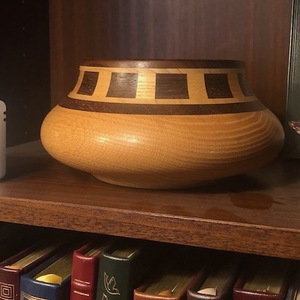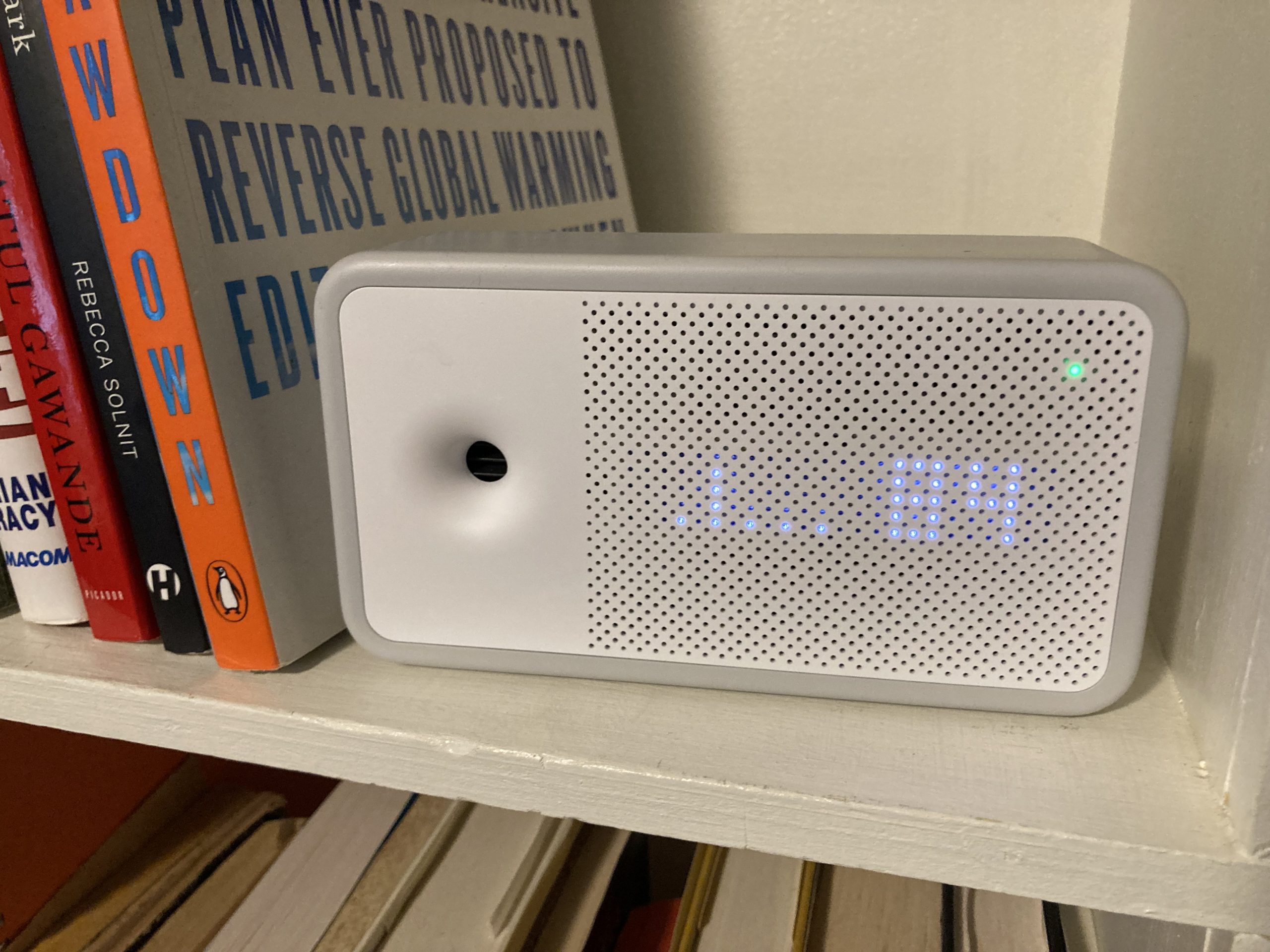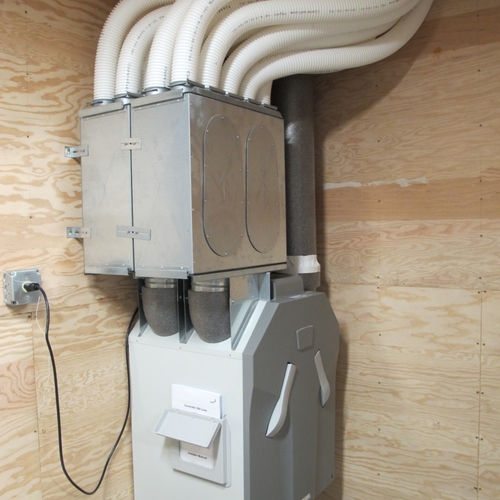
Green builders try to make their homes as tight as possible. To ensure good indoor air quality, green building programs (and many residential building codes) require new homes to have a mechanical ventilation system.
The aim, of course, is to provide enough fresh air to keep occupants healthy. To gauge whether a ventilation system is effective, many researchers measure indoor carbon dioxide (CO2) concentrations. (When humans and pets breathe, they consume oxygen and exhale carbon dioxide. The more people in a room, and the lower the ventilation rate, the higher the CO2 level is likely to be.)
There is some controversy around the question of how high CO2 levels need to be before the situation becomes worrisome. That said, there is increasing evidence that levels over 1,000 ppm raise concerns. (For more on this topic, see Stuffy Offices Lower Cognitive Function.)
CO2 levels are easier to measure than many other indoor air pollutants, so researchers often measure CO2 levels to determine whether a whole-house ventilation system is delivering enough fresh air to individual rooms.
Since high CO2 levels are associated with low ventilation rates, a high CO2 level is a warning sign that something may be wrong with indoor air quality.
People spend a lot of time in bed
Ideally, a ventilation system will provide fresh air to every room in a house. That said, some rooms are more important than others. For example, if a house has a pantry, it is probably occupied for only a few minutes a day. A bedroom, on the other hand, is usually occupied for at least 8 hours a day — making bedroom air quality far more important than pantry air quality.
Researchers interested in indoor air quality have long worried about the amount of fresh air reaching bedrooms, especially in homes with exhaust-only ventilation systems.…
Weekly Newsletter
Get building science and energy efficiency advice, plus special offers, in your inbox.

This article is only available to GBA Prime Members
Sign up for a free trial and get instant access to this article as well as GBA’s complete library of premium articles and construction details.
Start Free TrialAlready a member? Log in















27 Comments
A responsive system seems best
General rules of thumb never work as well as a measure-and-respond system (CERV, for example). Next best might be a balanced system that will bring in all fresh air through bedrooms and out through bathrooms.... but then one needs to keep the doors open or cut high.
O2 Chamber
Thank you for the excellent summary of Mr. Just's findings. This helps prove that pop singer Michael Jackson was genius.
Response to Brian Knight
Brian,
Since I don't make a habit of reading tabloid newspapers, I was unfamiliar with the reports that Michael Jackson was rumored (at one time) to sleep in a hyperbaric chamber delivering 100% oxygen. So I had to do some Googling.
Although your comment is tongue-in-cheek, I'd like to emphasize that there is no medical evidence that healthy people should sleep in a hyperbaric (above atmospheric pressure) environment, nor is there any evidence that 100% oxygen is the right gas to breathe.
In the 1950s, hospitals put premature babies in incubators that were hooked up to oxygen tanks that delivered 100% oxygen. Many of these babies became blind after developing retrolental fibroplasia as a direct result of the 100% oxygen environment. The blindness is permanent. Hospitals no longer use 100% oxygen for premature babies.
OK -- on to more serious issues.
Does anyone make CO2 meters
Does anyone make CO2 meters that can tie in with HRV/ERVs? That seems like it should have been an obvious step long ago. I'd love to have a system that ran based on feedback not assumptions.
Response to Calum Wilde
Calum,
Lots of web sites sell what you're looking for. Google "CO2 controller."
These devices are mostly purchased by people who grow plants indoors. (I wonder what species of herb they are growing?) The idea of these devices is to energize an appliance when the CO2 is too low -- so that the appliance can inject more CO2 into the grow room.
To use this type of controller to control a ventilation system, you would first plug a relay into the CO2 controller, so that the relay turned an appliance off, not on, when the controller detected that the CO2 levels are low. Not too hard to set up.
Here are links to one device that costs $221:
AutoPilot CO2 controller
AutoPilot CO2 controller instruction manual
If CERV is reading this.
I realize that their goal is to sell CERVs, but since there are a lot of HRV/ERVs out there that aren't going anywhere anytime soon, the company should package their sensor technology (WIFI and all) as a retrofit kit for existing HRV/ERVs. I have a feeling there would be market for it. I'm picturing a short section of duct with the touchscreen right on the side of it.
I've felt for sometime that the most significant short coming in balanced ventilation is the controls, they seem to be either totally inadequate or ridiculously over complicated.
Response to Andy Kosick
Andy,
Looking into the topic more deeply, I realize that demand-control ventilation (using CO2 sensors) is fairly common for commercial systems. There isn't any reason (other than cost) that commercial demand-control ventilation equipment couldn't be used for a residential system.
Here is a link to a manufacturer of demand-control ventilation equipment:
CO2 meter.com - Demand-controlled ventilation
Here is a link to an article about code requirements for commercial ventilation systems: Demand Control Ventilation
Is 1000 ppm the right standard for sleeping?
The studies I am aware of have set the target of 800-1000 ppm because that is the level at which cognitive function seems to begin decreasing. When I am sleeping, how much cognitive function do I really need?
CO2 sensors
Optional CO2 sensors that integrate with the HRV/ERV are already standard offerings for the premier brands. Zehnder, UltimateAir and Jablotron all have them. I'm sure there are others.
Response to Reid Baldwin (Comment #8)
Reid,
During his presentation, Brian Just cited one study that showed deleterious cognitive effects resulting from sleeping in rooms with CO2 above 1000 ppm. The Danish study was "The effects of bedroom air quality on sleep and next-day performance" by Strøm-Tejsen, Zukowska, Wargocki, and Wyon.
According to the study's Abstract, "Objectively measured sleep quality and the perceived freshness of bedroom air improved significantly when the CO2 level was lower, as did next-day reported sleepiness and ability to concentrate and the subjects' performance of a test of logical thinking."
Response to Trevor Lambert (Comment #9)
Trevor,
Thanks very much for that information. The paragraph shown below comes from the User Manual for the Zehnder ComfoAir 200.
.
Placing the CO2 sensor
I believe the CERV measures the CO2 in the air that is flowing through the ductwork, That works in a system like CERV that alternates between recirculation and ventilation, but wouldn't work in an ERV that alternates between off and on unless it came on periodically just to measure. Another issue is that if the ductwork is set up the normal way, it is measuring the CO2 of the bathrooms rather than the rooms that are occupied for long periods.
A CO2 sensor in the family room wouldn't do a good job of turning on the ventilation when the bedroom levels get high, especially with closed doors. Similarly, a bedroom sensor wouldn't turn the ventilation on when you have a family room full of people. You probably need multiple sensors each of which can turn on the ventilation. Maybe the boost mode controllers for bathrooms should include a CO2 sensor.
CO2 as a proxy
Do you have support for this statement?
This statement seems to be the safer one to make:
Looks like some good info in this study. And particularly interesting to see some common assumptions/myths challenged. My own less scientific testing has shown that closed-door CO2 doesn't drop appreciably when the air handler fan (only) is running, but it does during a cooling call (same fan speed). This is for an A/C-only system; my heating is via boiler. My guess is that you need a temp delta to get a convection going to actually mix the air in the room and dilute the CO2. That seems to align with Just's second myth. (My house is/was so leaky that the stack effect obviates any CO2 problem in the winter.)
My plan is to install an ERV after the attic is drywalled. In researching residential units up to ~100 cfm, it seems like there's a gap in the market for CO2 sensors and more sophisticated controls. I've used NDIR CO2 sensors in an IAQ prototype -- they are cheap. A Wi-Fi connected controller with a CO2 sensor could run as a standalone device or connect to a Nest or Ecobee via their respective APIs additional benefits.
Return air registers in bedrooms
I find it interesting that closing the door produced a CO2 spike even in homes with a forced air system. That suggests that there isn't much mechanical air movement into the room.
-were they running the furnace fan on continuous low speed?
-what was the weather like during the study? If heating demand was low and the fan was not set to run continuously, that would lead to poor movement.
-were the door undercuts blocked by carpeting?
-were there cold air returns in the bedrooms?
I'm skeptical that the door open effect is due to CO2 diffusing out of the room. Wouldn't it be more likely that opening the door would allow the furnace fan to push air into the room? If that's the case, it suggests that bedrooms should have cold air returns or, failing that, significant door undercuts.
Response to Jeremy Good (Comment #13)
Jeremy,
The two quotes you pulled from the article point in the same direction. I agree with you that the second of the two quoted passages is probably more technically accurate. The fact remains that if your bedroom has high CO2 levels, your ventilation system isn't doing its job -- and if there are other air pollutants of concern in your home, there's a good chance that your ineffective ventilation system is doing a poor job diluting the other pollutants, too.
Response to David Baerg (Comment #14)
David,
I don't have answers to most of your questions. There's always a chance that Brian Just will see your comments and respond.
I am hesitant to speculate, or to reach conclusions based on speculation. It's best to simply report the data.
Just reported that CO2 levels are much higher in bedrooms when the door is closed than when the door is open. It's up to readers to decide whether that information is useful, or whether it's worth acting on that information when they go to bed each night.
Response to Martin (comment # 16)
I would agree that this is a very good starting point for further research. I think we need to go deeper than suggesting that people keep their doors open if there are good reasons to keep them closed (fire safety - as long as there is a smoke detector in the bedrooms - privacy, noise). Figuring out why opening the door reduces CO2 concentration is the next step to developing strategies to keep CO2 levels low without requiring the occupants to keep their doors open. I would start by answering the above questions, measuring the flow at the registers with the door open and closed, measuring the door undercut and recording if there is a return register in the room. Are returns in bedrooms common in the US? It's been common here since 90s.
CO2 as a proxy
"Carbon dioxide is useful as an indicator of general air quality only in buildings where there are significant metabolic or combustion sources of carbon dioxide. "
http://publications.gc.ca/collections/Collection/H46-2-90-156E.pdf
"Particulate matter ≤ 2.5 μm in aerodynamic diameter (PM2.5), acrolein, and formaldehyde accounted for the vast majority of DALY losses caused by IAPs considered in this analysis, with impacts on par or greater than estimates for secondhand tobacco smoke and radon."
https://www.ncbi.nlm.nih.gov/pmc/articles/PMC3279453/
Great piece
I've long worried we don't really know what we're doing re ventilation - glad that studies like Brian's are starting to help.
Misc. notes
There is some thoughtful discussion here. A lot of the questions raised already have great answers given by others. I'll add a few notes:
- I hesitate to make sweeping discussions based on 30 or so homes, but well-designed ventilation is the one variable that consistently resulted in lower CO2 levels.
- We did not monitor heating periods, though if you look at data for individual homes (see the tail end of the slide deck I used for the BuildingEnergy Boston conference, available on the BuildingEnergy website) you can see behavior on some homes that could indicate furnace cycling. Note, however, that even if a furnace fan helps, you only get that benefit when heating/cooling or just running the fan (and as supply/return locations, undercuts, etc. allow). I wouldn't count on this strategy year-round, and even an ECM blower is going to consume substantially more electricity than most ventilation-specific equipment.
- Regarding a closed loop system, anecdotally, colleagues tell me that the CO2 feedback sensors in commercial systems don't hold calibration well. In any case, I question whether it's a real need. See the image below Martin's "Testing CO2 levels in homes with balanced ventilation systems" header. None of these homes had CO2 feedback and all performed well. All had fresh air supply in the bedroom. All had a central system that consumed just 10-20W (one was a home in the 2016-17 study that retrofitted their home last year - the pre- and post-retrofit data shows a stark difference). While the CERV or custom system with CO2 feedback may work best for some, good performance can be achieved without it. You could always consider buying or borrowing a low-cost desktop CO2 monitor that you can move around over the course of a few days or weeks if you want to fine tune a home’s system. Some ventilation systems have a “party” or boost mode that addresses the problem of large gatherings.
- The part around fresh air delivery to bedrooms seems key. In fact, the home with the second-highest CO2 peak in the 2016-17 study was a home with an HRV with decent flows, but where the nearest supply was in the hallway just outside the master bedroom. Again, compare to the three homes in the previous bullet, where door open / door closed nights are nearly indistinguishable and CO2 peaks are modest.
- If you install an HRV or ERV, I recommend investing a few hundred dollars extra on a high efficiency one with a high SRE, vs. an economy model. Back-of-the-envelope calculations show that payback is short, but the more substantial benefit might be better tempered air. These systems only tend to work if people like them and keep them turned on. Also consider a unit that can filter to MERV 13 or HEPA (not all have this capability) if present or future occupants decide they want this for health or other reasons. Good speed control, filter-loaded notification, and swappable ERV/HRV cores are other nice features.
- Joe Lstiburek has often spoken of ASHRAE 62.2 and overventilation. Consider Building Science Corporation's "Standard 01 - 2015", https://buildingscience.com/documents/special/ventilation-new-low-rise-residential-buildings. Unlike ASHRAE, it accounts for balanced (or not) and distributed (or not) systems; for a thoughtfully-designed balanced system it will yield a lower flow rate – which in theory could yield quieter operation, better tempered air, and less energy waste. Of course, testing air quality (as mentioned above) is a great strategy to fine tune a system to an individual home and occupancy.
- A final note is that many homes in the original study never dropped below 700-800ppm (or higher) CO2, even during the daytime. Contrast that with the homes with balanced ventilation that dropped to near-atmospheric CO2 levels relatively quickly once occupants left the room for the day.
Brian Just's final comments
Make me think the new ventilation requirements in our building code got it right. They require a balanced ventilation system, with supply to each bedroom and to the living area, and exhaust from the kitchen and bathrooms. No sensors or complications to worry about.
Challenging assumptions
"Most researchers agree that CO2 levels (which are easy to measure) are a good proxy for levels of other contaminants in the air that may be more difficult to measure." I think this statement means that there is a high correlation between CO2 and say, formaldehyde levels. I think this article suggests otherwise. In any event this a testable assertion. If Just were so inclined I would love to see him run a study on this and let us know the results.
Response to Thomas Nedelsky
Thomas,
Thanks for your comments. I have edited the problematic sentence; the new wording is more accurate.
As I noted in Comment #15, "If your bedroom has high CO2 levels, your ventilation system isn't doing its job -- and if there are other air pollutants of concern in your home, there's a good chance that your ineffective ventilation system is doing a poor job diluting the other pollutants, too."
Balanced ventilation exhaust distribution
Sorry to add to your work load there Martin and thanks for the further comments Brian. For IAQ monitoring, definitely prefer the idea of commissioning over adding room-by-room technology, even if calibration issues improve. Will more strongly consider the added technology of HEPA, filter indicators and swappable cores moving forward.
We have always installed balanced systems in our homes. We always run supply ducts to bedrooms and living areas but exhaust is usually pulled from air handler trunklines or convenient, central location while being mindful of short circuiting. We prefer dedicated spot ventilation for kitchen and baths. Running additional exhaust ducts for these rooms would add measurable costs for questionable benefits (if occupants use spot ventilation like they should).
I'm confused by Malcolm's comment about new ventilation requirements. It seems Section 403 added more language to balancing systems but looks like 403.3.2.3 still allows kitchen and bath spot ventilation only. It also seems 403.3.2.1 allows outdoor air be delivered via return side of air handler, not dedicated to bedrooms as they probably should. What am I missing?
Brian knight
Sorry, I should have been more clear. I was referring to the new ventilation provisions in our code here in British Columbia, which brought in mandatory full-time mechanical ventilation. While it does still allow exhaust only systems for one storey houses under 1800 sf, the location of supply and exhausts for both those and balanced systems seem to alleviate the problems Brian Just has found.
Challenging assumptions
Martin, some one might get the sense from your revised statement that if you go from poor dilution of CO2 to good dilution of CO2 you will have good dilution of, say formaldehyde. I know that is not your claim but I am curious to what degree that is the case. Needless to say lots of variables at play here.
Response to Thomas Nedelsky
Thomas,
In fact, I think it's logical to assume that if you are comparing two cases -- Case A without mechanical ventilation in the bedroom, and Case B with mechanical ventilation in the bedroom, with the following data points: Case A = elevated levels of CO2 that are worrisome, and Case B = much lower levels of CO2, such that they are below the level of concern -- then there is a very high likelihood that the levels of formaldehyde will be lower in Case B than Case A.
I'll admit that the study described on this page didn't show that, but I think it's not a crazy presumption.
Log in or become a member to post a comment.
Sign up Log in